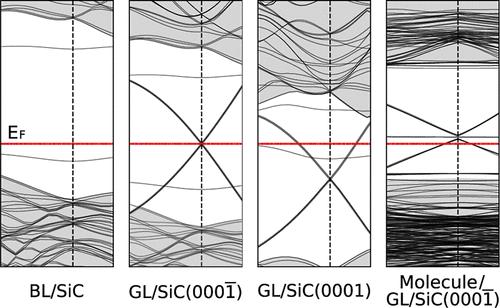Tunable Doping and Optoelectronic Modulation in Graphene-Covered 4H-SiC Surfaces
IF 3.2
3区 化学
Q2 CHEMISTRY, PHYSICAL
引用次数: 0
Abstract
Semiconducting graphene is pivotal for the advancement of nanoelectronics due to its unique electronic properties. In this context, silicon carbide (SiC) surfaces have been proposed as ideal supports for inducing semiconducting characteristics in graphene. Here, we employ many-body perturbation theory to investigate the electronic structure and optical properties of graphene-covered 4H-SiC surfaces. Our analysis reveals that pristine 4H-SiC surfaces with dangling bonds exhibit a reduced transport gap and enhanced optically active states within the visible spectrum compared to bulk 4H-SiC. Strong interfacial interactions resulting from the adsorption of a single graphene layer (GL) significantly alter graphene’s dispersion, yielding a semiconducting interface with modified optoelectronic properties. While the addition of a second GL restores Dirac dispersion, the two polar faces of the underlying 4H-SiC induce either metallic n-type doping or behavior similar to that of freestanding graphene. Furthermore, we investigate the adsorption of a molecular electron acceptor on SiC covered with one and two GLs. Our findings reveal notable renormalization of the molecular energy levels upon adsorption, resulting in the emergence of distinct new optically excited states. Additionally, a shift in the Fermi level, attributed to partial charge transfer, indicates effective p-type doping. The tunable doping characteristics and optical profiles across various energy ranges highlight the potential of graphene-covered 4H-SiC surfaces as versatile materials for a wide range of technological applications.

石墨烯覆盖的 4H-SiC 表面中的可调掺杂和光电调制
半导体石墨烯由于其独特的电子特性,对纳米电子学的发展至关重要。在这种情况下,碳化硅(SiC)表面被认为是石墨烯中诱导半导体特性的理想载体。本文采用多体微扰理论研究了石墨烯覆盖的4H-SiC表面的电子结构和光学性质。我们的分析表明,与本体4H-SiC相比,具有悬垂键的原始4H-SiC表面在可见光谱内表现出更小的传输间隙和增强的光学活性态。单石墨烯层(GL)吸附产生的强界面相互作用显著改变了石墨烯的分散性,从而产生具有改性光电性能的半导体界面。当添加第二个GL恢复Dirac色散时,底层的4H-SiC的两个极性面诱导金属n型掺杂或类似于独立石墨烯的行为。此外,我们还研究了分子电子受体在覆盖有一个和两个GLs的SiC上的吸附。我们的研究结果揭示了吸附后分子能级的显著重整,导致明显的新光学激发态的出现。此外,费米能级的移动,归因于部分电荷转移,表明有效的p型掺杂。在各种能量范围内可调的掺杂特性和光学轮廓突出了石墨烯覆盖的4H-SiC表面作为广泛技术应用的通用材料的潜力。
本文章由计算机程序翻译,如有差异,请以英文原文为准。
求助全文
约1分钟内获得全文
求助全文
来源期刊

The Journal of Physical Chemistry C
化学-材料科学:综合
CiteScore
6.50
自引率
8.10%
发文量
2047
审稿时长
1.8 months
期刊介绍:
The Journal of Physical Chemistry A/B/C is devoted to reporting new and original experimental and theoretical basic research of interest to physical chemists, biophysical chemists, and chemical physicists.
 求助内容:
求助内容: 应助结果提醒方式:
应助结果提醒方式:


